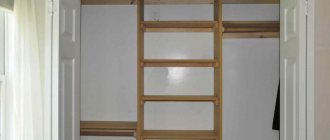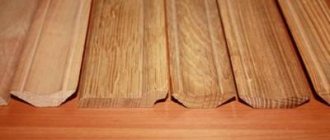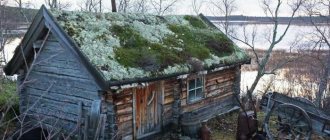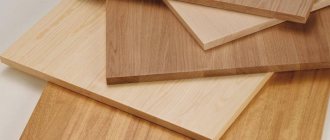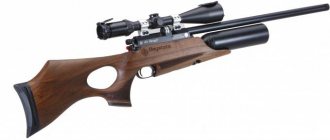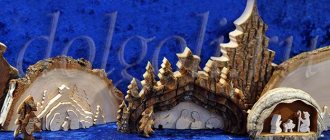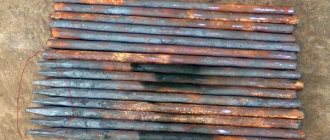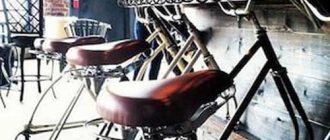A wood anchor is a combined independent fastening element fixed in wood fibers and designed to hold certain structures. This concept refers to a wide range of hardware that fulfills a wide variety of purposes and differs in two ways: method of application and appearance.
Anchor for working with wood Source cdn.stpulscen
What is meant by the term anchor
Translated from German, “Anker” means “anchor”. This term refers to a fastening element that is fixed in the supporting base and reliably holds a particular structure. The mounting method is different, depending on the type of product.
It differs from a dowel by the presence of a combined, independent fastening element. Along with the ability to be firmly held at the base, it reliably fixes the structure.
Connecting timber using an anchor Source marisrub.ru
The history of the existence of anchors stretches back centuries. For example, forged triangular and quadrangular pins are found in buildings dating back to Western European culture of the late Middle Ages. In some cases, they were used not only for constructive purposes, but also performed a decorative function. Thus, anchors driven into the facade of the building in the form of numbers displayed the date of construction.
Other types of fasteners
In addition to “anchors”, wooden structures can be connected using ordinary bolts, studs, perforated plates and corners.
Bolts
With their help, you can fasten two or more overlapping parts (however, the joined products must be quite thin). This method of fastening is convenient to use when building rafters: two boards are laid overlapping by three of their widths and, through pre-drilled holes, are tightened with two or three fasteners with nuts and wide washers.
Hairpins
The stud is similar, but has the advantage of having nuts on both sides. This fastener design allows you to tighten the fastener without turning the rod. This is convenient if the pin is jammed by the connected parts. In addition, if the rod is long, the force required to rotate it can be very large.
Corners and overlays
Perforated steel plates and angles should not be considered as competitors to anchors.
These types of fasteners complement each other:
using corners, you can join the floor joist boards with beams or crowns without cutting (butt-joint); plates allow you to connect boards in a similar way when splicing rafters or joists.
Important! To make such a connection reliable, choose a plate with a length of at least five times the width of the board. In addition, to fasten boards with overlays, you should use not “anchors” or self-tapping screws, but bolts with wide washers.
Conclusion
Understanding how different types of anchors interact with wood will help you choose the optimal solution to your problems.
Classification by method of application
Wood anchors are a general concept that refers to various types of fastening devices. There are 5 groups:
- Threaded. This means an anchor that screws into a previously prepared hole without additional spacer and locking elements. Fixation is achieved thanks to the increased thread diameter. Due to deep penetration into the wood structure, reliable fixation is achieved.
- Spacer. They are fixed in the base due to the frictional force that arises. To achieve maximum strength, the fastening part inserted into the hole is expanded by a wedge stop with an internal thread. The latter can be a plastic, steel or galvanized dowel.
- Persistent. Fastening is achieved by monolithing the expanded or ribbed part of the hardware. Anchors screwed into the tree and foundation are built using this principle. Those that are used to fix a reinforced concrete base with the walls of a wooden or frame house.
- Glue. Adhesion to the base is ensured by filling the hole with an adhesive composition into which the anchor rod is inserted.
- Bolt Molly. Such hardware is used when it is necessary to fix hinged elements to partitions made of hollow materials: boards, timber, sheet wood panels. At the moment of twisting the rod, its thread expands the outer shell. At this moment, a larger area of support is created on the opposite side. It ensures reliable fixation and strong contact with the surface of the septum.
Interesting! Another name for adhesive wood anchors is chemical.
Threaded
One of the simplest and most popular types of anchors. The working part has a deep thread, due to which fixation is ensured. The tip is pointed, which allows you to screw in hardware without first drilling a hole. However, as a result of working with fragile wood fibers, there is a high probability of damage and cracking.
Wood grouse anchor Source b2b.bohrer.ru
Spacers
As already mentioned, the wood expansion anchor is fixed into the previously prepared hole. Moreover, the diameter of the latter must correspond to the size of the hardware. The element consists of two units: a threaded plug and a rod that is screwed into it. Fixation is carried out at the moment of screwing and wedging the wedge stop, which digs its outer walls into the edges of the hole.
Expansion type anchor Source enkor24.ru
Persistent
The operating principle of a thrust anchor resembles the fixation method used in expansion anchors. The difference is that here the fixation is achieved by wedging the ribbed or flared part. As mentioned earlier, wooden buildings installed on monolithic strip or slab foundations are fixed in this way.
Wood anchor working according to the thrust type Source g-kabel.ru
Adhesive
Anchor glue for wood is mainly used in work with hollow brick or reinforced concrete bases. It is not used so often for working with wooden bases. The principle of operation is to fill the hole with a special chemical composition. After this, an anchor (metal pin, bolt or other device) is inserted into it. During the curing process, the adhesive component expands, filling the free space and forming a strong monolithic contact.
In most cases, chemical anchors are sold with a two-component adhesive composition, which is prepared immediately before performing work. Classification occurs due to the form of release.
Ampoule. It is sold in the form of a cylinder filled with a substance that hardens upon contact with air. Mostly the kit contains a separate hardener capsule or an internal partition that separates the reagents from each other. After it is installed in the drilled hole, the screwed hardware breaks through the shell and the glue hardens.
Wedge
An anchor of this type, the spacer or wedge sleeve of which has a shortened length, is also a modification of a fastener with a nut. The wedge element that expands such a bushing is the reverse end of the threaded part of the bolt, which has a conical shape.
The big advantage of using them is that for their reliable fastening there is no need to maintain the exact diameter of the mounting hole; moreover, it does not need to be cleaned of construction dust. Such a bolt is secured in the mounting hole, and its spacer element is expanded by tightening the nut.
Execution options
Classification according to this criterion is carried out according to the appearance of the outer part of the hardware, which remains visible after its installation. Here, wood anchor bolts are divided into 4 groups:
- Anchor bolt. A classic hex head fastener designed for virtually any application. This can be used to hang a kitchen set or securely fix one or another element.
- Stud anchor. The most popular application is splicing or extending timber building materials. For example, a mauerlat or other element from the roofing or ceiling system of a country house. It is inserted into a previously drilled hole, after which it is tightened with a wrench or wrench.
- Anchor hook. The device is not used to splice or connect two elements. Due to the hook on the outside, it is used as a suspension. The most popular example of purpose is hanging a SIP cable on the facade of a building. Garden lanterns, chandeliers, and hanging shelves are also fixed in this way.
- Ring anchor. Performs functions similar to the above. The difference is that a closed circle (ring) does not allow an object suspended on it to jump off during any movement in space. An example is a swinging children's swing. There are also anchors with spring or threaded carabiners.
Drivers
A drive-in anchor is the simplest anchor-type fastener, the design of which consists of a spacer sleeve with a conical-shaped internal hole. To install this at the required point of the building structure, it must be hammered into the mounting hole, and then a threaded element must be screwed into it, which will ensure the expansion of the bushing petals.
The material for the manufacture of such fasteners, the correct installation process of which can be seen in the video, can be galvanized steel or brass.
KGS 215-5-P KGS 240-5-P KGS 265-5-P KGS 165-7-P KGS 190-7-P KGS 215-7-P KGS 240-7-P KGS 265-7-P KGS 290 -7-P KGS 315-7-P KGS 340-7-P KGS 365-7-P KGS 465-7-P KGS 565-7-P
Design
The combined flexible connection consists of the following elements: — L-shaped tip (coupling) made of stainless steel; — basalt-plastic rod with a continuous sand coating. To secure the heat-insulating layer in a wall structure that has a ventilated gap, a plastic fastener is used (supplied separately).
Specifications
| 1000 | 47,10 | — + | Buy |
| 1000 | 47,50 | — + | Buy |
| 1000 | 47,90 | — + | Buy |
| 700 | 73,70 | — + | Buy |
| 600 | 74,30 | — + | Buy |
| 500 | 75,50 | — + | Buy |
| 500 | 76,20 | — + | Buy |
| 500 | 76,90 | — + | Buy |
| 500 | 77,70 | — + | Buy |
| 500 | 78,30 | — + | Buy |
| 500 | 79,10 | — + | Buy |
| 400 | 80,10 | — + | Buy |
| 400 | 82,90 | — + | Buy |
| 400 | 85,80 | — + | Buy |
| Flexible link length | from 165 to 365 mm |
| Rod diameter | 5 or 7 mm |
| Length of the connection point between the coupling and the flexible connection (anchoring depth) | 20 mm |
| L-Tip Hole Diameter | 7 mm |
| Tensile strength of the rod, not less | 1,000 MPa |
| Strength of the rod when bending, not less | 1,000 MPa |
| The force of breaking the connection from the building foundation | Depends on fastener |
Suburban construction today: tree anchor
Our online store presents a professional assortment of modern construction fasteners, which are distinguished by high quality and reliability, so today everyone can quickly and easily - thanks to the detailed descriptions and photos posted in the relevant sections, as well as expert advice from duty managers - select the most suitable suitable for the implementation of a specific project in terms of construction (repair or finishing). Products that are widely in demand on the North-Western market, in particular, wood anchors, are popular, first of all, due to the strength and traditional materials of manufacture, as well as due to a simple, but extremely effective device that ensures reliable fastening of wooden building structures, including , to the brickwork.
Anchor for wood, buy on the most favorable terms with delivery throughout St. Petersburg and the Leningrad region, is indispensable for the construction of low-rise residential buildings (structures) using the so-called “frame” technology, which is very popular today among those who decide to live and/or relax in the countryside, away from the, to put it mildly, “unhealthy” atmosphere of a noisy metropolis. When creating durable and attractive cottages, wood is chosen as the material for load-bearing walls, and the design can be anything from classic country style to original designer solutions. Due to the unique ability to “breathe”, wood creates a comfortable, cozy and healthy microclimate indoors, and also allows the owner to significantly save energy, which in the case of construction from artificial composite materials - for example, aerated concrete or sand-lime brick - will be used for heating in the cold season and air conditioning in warm.
To ensure reliable protection of a building (structure) from bad weather, which is important for the capricious climate of the North-Western region, characterized by large amounts of precipitation, low and often unexpectedly changing temperatures, strong winds, as well as mechanical stress, ceramic bricks are used: wood anchor, price The fastener is installed more than democratically, it will create a reliable and durable connection between the base and the cladding. It is interesting that in this way old houses are often effectively and relatively inexpensively updated (expanded, strengthened, etc.). Buying a wood anchor is a good solution for a wide variety of wooden building materials, including rounded logs and slab materials made of wood, plywood and wooden beams; a wide range of sizes makes it possible to select an anchor for wood of the optimal length in accordance with the parameters of a specific load-bearing wooden wall.
Wood anchor: modern "special purpose" construction fastener
Relatively inexpensive anchors for wood, purchased online in St. Petersburg and the Leningrad region with delivery, are currently made from high-quality stainless steel, characterized by high corrosion resistance and strength. As a rule, the spacer-connecting element (also known as an anchor) for wood is equipped with a thread at one end, which allows installation using a special adapter without preliminary drilling, and the opposite end of this fastener has a complex geometry, due to which the anchor for wood will last for a long time time is firmly held in the masonry seam, reliably fixing the facing layer of ceramic bricks to the supporting wooden structure.
In terms of the number of commonly used fastening elements, it is recommended to use 6 to 8 wood anchors per square meter to ensure that the final building structure is durable and stable. If the project involves creating a ventilation space between the facing brickwork and the insulation layer, then it is necessary to supplement the anchors with special plastic clamps, which are easily attached to the spacer-connecting element and firmly fix the insulation (for example, a basalt slab) at a given distance from the ceramic bricks. As practice shows, such a gap ensures optimal removal of excess moisture from the surface of the heat-insulating layer throughout the entire operational life of the building (structure).
What is an anchor: general information
In general, an anchor is usually called a fastener that can withstand significant loads and is made of galvanized metal for fixing heavy monolithic (solid) building structures (also products or equipment) in such solid bases as wood (concrete, brick, natural stone); the word itself comes from the German language and, translated, means, of course, “anchor.” The element is held in the material by abutment or friction, and the reliability of the fastening is ensured by pushing the anchor into the working hole using a special device: it can be a wedge or a nut, a screw or a bolt. Today, experts distinguish several types of anchors - not only by design or material of manufacture, but also by purpose.
An anchor for wood, which can now be purchased quickly and easily on a website with intuitive navigation, ensures optimal pairing of individual structures (load-bearing wooden walls, an insulation layer if available, an external protective and decorative layer of ceramic bricks) during construction using the widely used “frame” » method, as well as when using any natural wood building materials popular on the local market - both modern and traditional. Without exception, all fasteners presented are equipped with certificates confirming compliance with state quality standards provided by a responsible manufacturer.
To use various wood compounds in the field of construction, you cannot do without just tools, but also without the appropriate experience. That is why inexperienced craftsmen do not always make such connections accurately. One of the best options is for professionals to use a variety of array fasteners that are made of metal.
Many surviving architectural monuments made of wood were built without nails, using only an ax. This fact causes true pleasure to this day. However, centuries later, the fasteners made of metal, used to build solid wood buildings, have changed radically, and it is for this reason that today it makes no sense to repeat the experience of our ancestors.
It is preferable to build quickly and without difficulties. Let's talk in more detail about the fasteners offered by manufacturers, taking as an example details that make it possible to simplify as much as possible the connection of beams with floor joists or solid wall surfaces.
Working with anchors
Working with anchor bolts in wood has its own specifics. The key point here is that if the hole diameter is inappropriate or if there is excessive stress, the wood fibers can break. The installation itself looks like this:
- A hole is drilled at the previously marked point. When using spacer or thrust hardware, their size must match exactly. For screw-in ones, take a diameter 1-2 mm smaller than the anchor (for example, for a 10 mm bolt an 8 mm hole is prepared). Chemical fasteners, on the contrary, imply a larger width, since you will first need to introduce glue, which will expand during the hardening process.
- Next, the hole is cleared of chips. When using screw-in anchors, this step can be skipped. For all other types, cleaning is recommended.
- Hardware, the fixation of which is carried out through mechanical contact with the walls of the hole, requires preliminary lubrication. A small amount of soap solution or a couple of drops of car oil will make the installation process easier. In addition, improving the sliding properties of materials will reduce the likelihood of cracking of wood fibers.
- At the final stage, the wood anchor is installed in the hole and tightened. The method that will be used in each specific case depends on the type of fastener. It must be taken into account that with excessive force, the hardware may turn or be torn out of the soft wood structure.
The principle of working with wood anchors Source krep-komp.ru
Important! The hole for the wooden anchor is drilled to a depth that matches or slightly exceeds the size of the hardware. If this condition is not met, a sharp increase in the force on the fibers will lead to the formation of cracks. In addition, this may not happen immediately, but after some time.
Installation
How to screw in an anchor with your own hands, ensuring maximum fastening strength and without splitting the wood?
The instructions are no different from those for any screw of significant diameter:
- At the attachment point, a hole with a diameter approximately equal to the diameter of the anchor along the thread recesses is pre-drilled. Let's say, for a 10 mm fastener, a hole is drilled with an 8 mm drill;
A hole must be drilled for the fasteners.
An important point: the hole is drilled along the entire length of the anchor. If you make it shorter, the force pushing the wood apart will increase sharply, which can still lead to the appearance of cracks in the future.
- Apply a small amount of liquid or solid soap to the threads. It will serve as a lubricant;
- The anchor is screwed in to its full depth.
Advantage of using anchors
The main advantage of working with wood anchor bolts in comparison with conventional nails or self-tapping screws (screws) is the strength and reliability of fixation. For example, for the fasteners under consideration, the pullout load is 300-350 kg. This parameter is considered a high indicator and allows them to be used to fix almost any heavy object. For comparison, the same figure for a regular carpenter’s nail is no more than 100 kg.
Anchor with a ring for wood Source cki-com.ru
In addition, working with anchors is simple and does not take much time. Although for their installation you first have to drill a hole, taking into account the fact that screwing requires less effort than when working with screws, these hardware are the leaders in this indicator.
All types of anchors have an anti-corrosion zinc coating, which reduces the likelihood of rapid corrosion. Therefore, there is no need to fear for the integrity of the structure. Nails and most screws do not have this effect. In addition, there are special devices designed for use in rooms with high humidity: steam rooms, showers, saunas. This also contributes to the popularization of hardware when compared with possible analogues.
Use of wood anchors Source 8kr.ru
We should not forget about the thickness and corresponding strength of the created structure. For example, the diameter of the shaft of a conventional screw or self-tapping screw is only 3.2-4.5 mm. Anchor bolt sizes start from five millimeters or more. This also affects the final quality of the created connection.
Fastening the Mauerlat with an anchor Source sdelai-lestnicu.ru
Wood fasteners
Fasteners suitable for connecting wooden structures have several features:
- the large thread diameter (from 6 mm to 14 mm or more) compensates for the relatively low mechanical strength of the base;
- the moisture content of wood can fluctuate significantly at different times of the year and under different indoor conditions, therefore, to avoid corrosion, fasteners must be protected by brassing or galvanizing, or be entirely made of corrosion-resistant materials;
- the large diameter of the rod requires significant force when screwing it in. Since slots for a Phillips or flat-head screwdriver are not designed for such loads, the “anchor” is most often equipped with a hex head rather than a slotted one. For screwing, use an open-end or socket wrench, or a socket head.
Welding to restore threads
In order to seal a hole on a damaged surface, welding can be used. Among the features we note the following points:
- A variety of cooking methods can be used.
- The restoration process can become more difficult if the hole is long.
- After welding the hole, cutting is carried out using a tap.
Read also: How to cut splines inside a bushing
The process is quite simple, but the resulting turns will not be able to withstand high loads.
Special purpose self-tapping screws
Using similar elements, fairly massive wooden products are attached. The cap has milled ribs and is easily recessed into the product, while the tip is created like a drill. In the middle of the screw, the cutter makes a larger hole, helping to tighten the element as tightly as possible.
An adjustable self-tapping screw will be useful for fastening door frames, window openings, and solid wood sheathing to wood and metal. The self-tapping screw is screwed directly into the box, as well as the wall surface located behind it, or the power part.
The self-tapping screw acts as a weather vane for high-quality fastening of solid wood cladding to a base made of steel. It has a tip in the form of a drill and wings placed above it to expand the hole in the tree.
When drilling metal products, the wings break. As a result, having made a thread in a metal part, the self-tapping screw fits tightly to it, while the solid element is attracted by its head to the metal.
Tenon and groove
This galvanized wood fastener consists of a tongue and groove section that fit together to provide better transfer of horizontal as well as vertical forces.
The connection can be visible or hidden; for these purposes, the steel parts are recessed into special grooves in advance.
Three-dimensional slats
The modern Italian company produces fastening elements that are placed perpendicularly and vertically at an angle, using T-type slats created by extrusion from a high-strength steel alloy. They are produced in several modifications designed for different levels of loads.
The fastening system must be selected according to the size range of sections of the combined beams and the dynamic as well as static loads acting on them.
During the installation process, the slatted base is attached to the beam using self-tapping screws. Then a groove of the same size as the slatted shelf is created on the end part, attached to the base of the joist beam. If there is no perforation, the shelf is equipped with a log and the connection is secured using self-tapping screws.
How to screw a screw into a loose hole?
If the hole has become so loose that the screw fits too loosely, try the following:
- Thickly coat the screw threads with PVA glue, dip the screw in sawdust and screw it in. ...
- Use a larger screw. ...
- Seal the hole with a wooden plug.
Interesting materials:
What grounds should there be for checking documents? What printed documents does UPD replace? What are the storage periods for archival documents? What methods of saving a document are there? What services can I get with my documents? What services do my documents provide? What types of objects can be inserted into a document? What types of organizational documents do you know? What document is used to document the investigation of an industrial accident? What regulatory document should individual entrepreneurs follow when filling out travel forms?
Hidden details Hedgehog
These connectors are steel washers, the base of which is equipped with holes drilled under the slope. These holes are for self-tapping screws. In the center of the washer there is a threaded hole into which a pin is inserted. Its free end is threaded into a special hole and secured on the back side of the beam with a piece with an enclosed washer.
The created connection functions perfectly not only in pull-out, but also in shear. If there is excessive load in the area of the end part of the joist, it is possible to install several elements at the same time.
Selecting Cold Weld for Threads
There are various types of the substance in question on sale. When choosing, the following points are taken into account:
- Recommended area of application.
- Features of manufacturing the working mixture.
- Operating conditions: temperature, humidity and some other points.
Restoring threads by cold welding
Most versions are represented by two components that are mixed to obtain a paste. It is worth considering that the substance does not remain in a plastic state for long.
